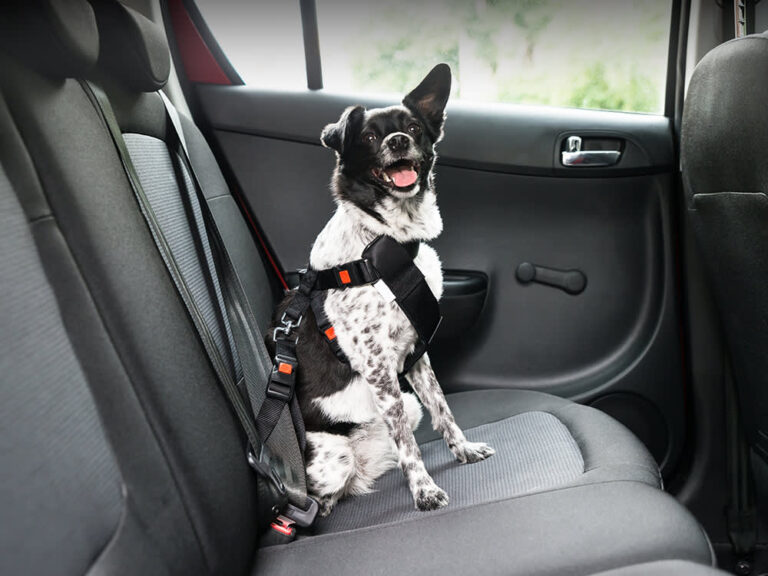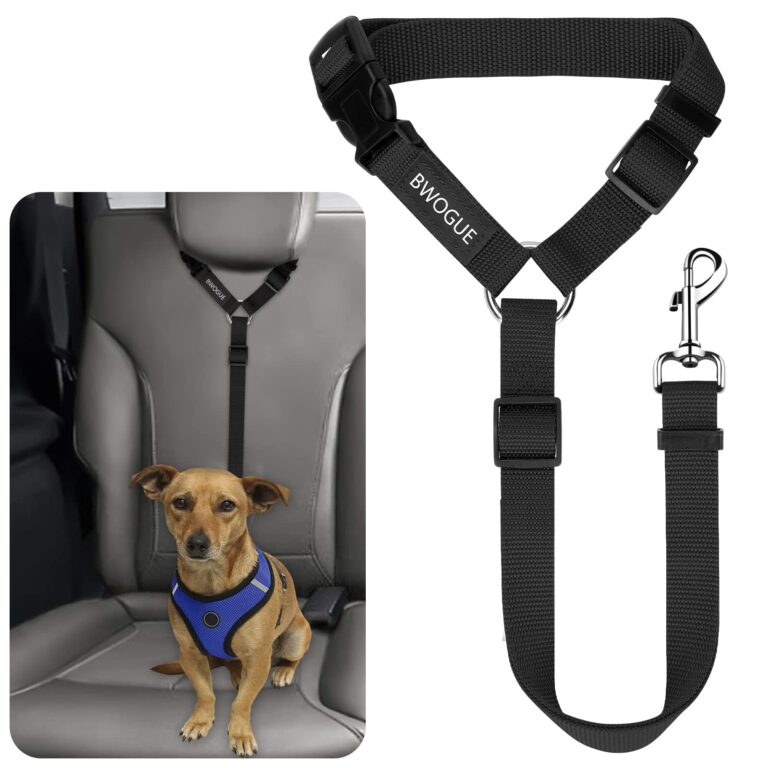Why You Shouldn’t Leave a Harness on a Dog: Vital Insights
Leaving a harness on a dog can cause discomfort, skin issues, and potential accidents. Dogs need breaks from harnesses to stay healthy and safe.
A harness that is left on for extended periods can lead to chafing, irritation, and restricted movement. Additionally, dogs may get tangled or caught on objects, risking injury. Regularly removing the harness allows the dog’s skin to breathe and prevents any discomfort or health issues.
Remember to provide your furry friend with breaks from wearing a harness to ensure their well-being and happiness.
The Risks Of Continuous Harness Wear
Leaving a harness on a dog for extended periods of time can lead to various risks and health issues. While harnesses are commonly used for walking and training purposes, it is important to understand the potential dangers associated with continuous wear. In this article, we will explore two significant risks: skin irritation and hair loss, as well as restricted movement and muscle development.
Skin Irritation And Hair Loss
Continuous harness wear can cause skin irritation and hair loss in dogs. The constant rubbing and pressure from the harness against the dog’s skin can lead to redness, inflammation, and discomfort. Over time, this irritation can escalate, causing the dog to scratch or chew at the affected area, further exacerbating the problem. Additionally, the friction between the harness and the dog’s fur can result in hair loss, leaving bald patches or thinning of the coat. This not only affects the dog’s appearance but can also impact their natural ability to regulate body temperature.
Restricted Movement And Muscle Development
Wearing a harness for prolonged periods can restrict a dog’s movement and hinder proper muscle development. Harnesses are designed to distribute force evenly across the body, but when worn continuously, they can limit the dog’s range of motion. This restriction may prevent the dog from engaging in natural behaviors such as stretching, running, and jumping. Without the ability to move freely, the dog’s muscles can weaken, leading to decreased strength and agility. Regular exercise and unrestricted movement are vital for a dog’s overall health and well-being.
It is crucial to remember that while harnesses are beneficial tools for controlling and guiding dogs, they should not be left on for extended periods. Regularly remove the harness to allow the dog’s skin to breathe and prevent any potential discomfort or health issues. Always follow the manufacturer’s guidelines for harness usage and consult with a veterinarian if you notice any signs of irritation, hair loss, or restricted movement in your dog.

Credit: www.reddit.com
Chafing And Sores: The Hidden Dangers
Chafing and sores can pose hidden dangers when leaving a harness on a dog for extended periods. These issues may not be immediately noticeable, but they can lead to discomfort and pain for your furry friend. Identifying problem areas, and understanding the crucial factors of materials and fit, is essential in preventing these risks.
Identifying Problem Areas
When a harness is left on a dog for too long, it can cause chafing and sores in specific areas. The chest, shoulders, and underarms are common trouble spots where the harness may rub against the skin, leading to irritation and potential injury. Regularly inspecting these areas for any signs of redness, swelling, or hair loss is crucial in identifying and addressing these problem areas promptly.
Materials And Fit: The Crucial Factors
The materials of the harness play a significant role in preventing chafing and sores. Opt for soft, breathable fabrics that reduce friction and allow for airflow. Additionally, ensuring a proper fit is crucial. A harness that is too tight can dig into the skin, while a loose harness may cause excessive rubbing. Proper adjustment and regular checks on the fit can help prevent these issues.
Harness As A Safety Tool, Not A Garment
Leaving a harness on a dog for extended periods can be dangerous. While it may seem like a convenient way to control your pet, harnesses are meant to be safety tools, not garments. A harness left on for too long can cause skin irritation and even restrict a dog’s breathing.
The Original Purpose Of Dog Harnesses
Dog harnesses were originally designed as a safety tool to help control dogs during walks and other outdoor activities. It was also used as a tool for training dogs to walk on a leash without pulling or tugging. Harnesses were never meant to be used as a garment or left on a dog for extended periods of time. Unfortunately, many dog owners misunderstand the purpose of the harness and leave them on their dogs for too long, which can cause serious health problems.When To Appropriately Use A Harness
When used appropriately, a harness can be a helpful tool for dogs and their owners. A harness can be used for controlling your dog during walks, especially for dogs who tend to pull or have difficulty walking on a leash. A harness can also be used for car rides to keep your dog safe and secure. However, it is important to remember that a harness should never be left on a dog for extended periods of time. Some reasons to avoid leaving a harness on a dog for too long include:- Chafing and irritation
- Restricted movement and breathing
- Pressure sores
- Overheating
Behavioral Concerns And Training Impacts
Leaving a harness on a dog can lead to behavioral concerns and training impacts. It may cause discomfort, skin issues, and restrict natural movements, affecting the dog’s well-being and training progress. Regularly remove the harness to prevent any negative consequences.
Harness Dependency
Leaving a harness on a dog for extended periods of time can lead to a range of behavioral concerns and training impacts. One of the main issues that arises is harness dependency. Dogs are intelligent creatures and quickly learn to associate the feeling of the harness with the ability to walk or engage in activities. When a dog becomes reliant on the harness, it can hinder their ability to learn and follow commands without it.Training Setbacks
Using a harness during training is a common practice, but it is important to remove it once the training session is over. Failure to do so can result in training setbacks. Dogs may become confused and struggle to differentiate between training sessions and regular walks if they are always wearing the harness. This can lead to a lack of focus and obedience during training, as the dog may rely on the physical cues provided by the harness instead of listening to verbal commands.Behavioral Concerns
Wearing a harness for prolonged periods can also contribute to behavioral concerns in dogs. The constant pressure and restriction on their bodies can cause discomfort and anxiety. This can manifest in various ways, such as increased agitation, restlessness, or even aggression. Additionally, leaving a harness on a dog for extended periods may restrict their natural movements and inhibit their ability to engage in normal behaviors, leading to frustration and potential behavior problems.Training Impacts
When a dog becomes dependent on a harness, it can hinder their overall training progress. Training should focus on building a strong bond between the dog and their owner, as well as teaching them to respond to verbal cues and commands. However, harness dependency can undermine these goals by shifting the dog’s focus to the physical sensation of the harness rather than the owner’s instructions. This can result in slower progress and a lack of consistent obedience, ultimately affecting the effectiveness of training efforts. In conclusion, leaving a harness on a dog for extended periods can have negative behavioral and training consequences. Harness dependency can hinder a dog’s ability to learn and follow commands without the physical cues provided by the harness. It can also lead to training setbacks and behavioral concerns, as the constant pressure and restriction can cause discomfort and anxiety. Therefore, it is important to use a harness responsibly and remove it when it is not needed for training or walking purposes.The Escape Artist: Increased Risk Of Slipping Out
Leaving a harness on a dog poses dangers, especially with their natural tendency to slip out. Dogs are escape artists, always finding ways to break free.
Security Vs. Safety
Security encompasses keeping a harness on for control, but safety should come first to prevent accidents.
Assessing Harness Fit Regularly
Ensure the harness fits snugly by checking regularly to prevent slipping out and potential harm.
:strip_icc()/sps-dog-harnesses-test-ruffwear-front-range-amazon-front-attachment-good-hiking-hang-pham-03-a1cde46513054c8c9098c82c71b82c8b.jpeg)
Credit: www.thesprucepets.com
Maintaining Hygiene And Comfort
Leaving a harness on a dog can compromise their hygiene and comfort. It can lead to skin irritation, chafing, and even potential injuries. It’s important to remove the harness after walks or outings to ensure your dog’s well-being.
Maintaining Hygiene and Comfort: A dog harness is a great tool for walking and training your furry friend. However, leaving it on your dog for extended periods can lead to hygiene and comfort issues. In this section, we’ll explore the importance of routine cleaning and inspection, as well as alternatives to constant harness use. Routine Cleaning and Inspection: Just like any other piece of pet equipment, a dog harness requires routine cleaning to maintain hygiene. Leaving a dirty harness on your dog can lead to skin irritation, rashes, and even infections. Therefore, it’s crucial to clean the harness regularly, especially after outdoor activities or prolonged use. Inspecting the harness for wear and tear is equally important. A damaged harness can cause discomfort and even pose a safety risk to your dog. Check the stitching, buckles, and straps for any signs of wear and replace the harness if necessary. Alternatives to Constant Harness Use: While harnesses are useful for walking and training, they shouldn’t be worn constantly. Allowing your dog to go without a harness for a few hours each day can help maintain their comfort and hygiene. Consider alternative equipment, such as a collar or leash, for shorter walks or indoor activities. It’s also important to train your dog to be comfortable without a harness. This can help reduce anxiety and stress when the harness is removed. Start by gradually increasing the time your dog spends without the harness, and use positive reinforcement to encourage good behavior. In conclusion, leaving a harness on your dog for extended periods can lead to hygiene and comfort issues. By practicing routine cleaning and inspection and using alternative equipment, you can ensure your furry friend stays healthy and happy.Sensory Implications And Stress
When it comes to your furry friend’s well-being, it’s crucial to understand the sensory implications and stress associated with leaving a harness on a dog. While harnesses are essential for walks and outings, prolonged use can have adverse effects on your dog’s comfort and mental state.
Pressure Points And Sensory Overload
Leaving a harness on your dog for extended periods can lead to discomfort and even pain due to pressure points. Dogs have sensitive areas on their bodies, and constant pressure from a harness can cause irritation and discomfort, leading to sensory overload and stress.
Reading Your Dog’s Comfort Signals
It’s vital to pay attention to your dog’s body language and behavior to understand their comfort level. If your dog shows signs of restlessness, tries to remove the harness using their mouth, or exhibits unusual behaviors, it could indicate distress caused by the harness.
Legal And Ethical Considerations
Local Laws And Harness Requirements
When it comes to keeping dogs safe, it’s crucial to understand the legal and ethical considerations of using a harness. Local laws and regulations often dictate the proper use of harnesses for dogs. Municipalities may have specific requirements regarding the use of harnesses, including when they should be worn and when they should be removed. It’s important for dog owners to familiarize themselves with these laws to avoid any legal issues.
The Debate On Constant Harnessing
There is an ongoing debate about the constant use of harnesses on dogs. Some argue that leaving a harness on a dog for extended periods can lead to discomfort and potential health issues. Ethical concerns also come into play, as the prolonged use of a harness may restrict a dog’s natural movements and behaviors, affecting their overall well-being. It’s essential to consider the ethical implications of keeping a harness on a dog at all times, especially when it comes to their freedom and comfort.

Credit: www.facebook.com
Frequently Asked Questions
Is It Bad To Leave A Harness On A Dog All The Time?
Leaving a harness on a dog all the time is not recommended. It can cause discomfort, skin irritation, and restrict movement. Dogs should only wear harnesses during walks or other activities. It’s important to remove the harness and give your dog breaks to prevent any potential health issues.
Why Should You Not Use A Harness On A Dog?
Using a harness on a dog can restrict natural movement. It can lead to chafing, discomfort, and potential injury. Additionally, harnesses can encourage pulling behavior. Instead, consider using a properly fitted collar and leash for better control and comfort.
Should I Take My Dogs Harness Off At Night?
It is generally recommended to remove your dog’s harness at night to allow them to rest comfortably. This helps prevent any potential discomfort or restriction of movement while they sleep. Removing the harness also allows their skin to breathe and reduces the risk of irritation or chafing.
Why Do Dog Trainers Not Like Harnesses?
Dog trainers may not prefer harnesses as they can encourage pulling behavior. They may also restrict natural movement and communication between the dog and the handler. Instead, trainers may opt for collars for better control and training.
Conclusion
Ensuring your dog’s safety means removing the harness when not in use. Avoid potential risks by being cautious and attentive to your pet’s comfort. Remember, a happy and healthy dog is a loved dog. Take the extra step to protect your furry friend’s well-being.
- Can I Get in a Taxi Without a Car Seat? - January 26, 2025
- Can I Get Chlamydia From a Toilet Seat? - January 26, 2025
- Can I Get an Uber With a Car Seat? - January 26, 2025






